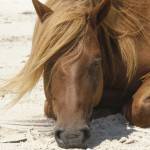Achy Joints and Sleep Deprivation in Horses

Daily sleep duration recommendations for humans depend largely on age—newborn and infants may spend more than half of each day asleep, while adults devote much less time to slumber, perhaps seven to nine hours. Have you ever considered how much sleep your horse requires for its well-being?
In a paper titled “The Characteristics of Equine Sleep,” published more than 40 years ago, equine behavior expert Katherine Houpt, V.M.D., Ph.D., summarized her observations: “Horses sleep three hours of each 24 hours, mostly at night, but they sleep only for brief periods. They sleep when recumbent, maintaining sternal recumbency during slow-wave sleep (the phase without rapid eye movement [REM]) and lateral recumbency during paradoxical sleep (the REM phase). Two hours a day are spent drowsing, and this increases in warm weather. Sleep in horses is affected by changes in diet and by environmental disturbances.”*
Aside from management differences, researchers at São Paulo University in Brazil wondered if resting and lying behavior changed during hospitalization in horses with joint disease of various severity.**
For the study, eight Lusitano mares were placed in deeply bedded stalls of the same size. All of the mares were diagnosed with osteoarthritis of the fetlock joint. Severity of osteoarthritis was determined by lameness examination, radiography, and ultrasound, with each examination performed and scored by a different individual with no knowledge of the opinions of other examiners.
Using cameras, mares were then observed continuously during the first five days of hospitalization. Time in each of the following activities was recorded:
- Wakefulness duration: standing with eyes open and head above withers; eating or resting limb
- Drowsiness duration: standing with head below the withers, eyes open or closed
- Right or left lateral recumbency duration: legs extended; head, chest, abdomen in contact with the stable floor; eyes closed
- Right or left sternal recumbency: lying on chest; legs flexed and tucked under body; eyes open or closed; muzzle may be in contact with the stable floor
- Frequency of lying down
According to the researchers, “the severity of disease appeared to affect recumbency time, as horses with mild osteoarthritis spent more time in recumbency while those with severe osteoarthritis may have been partially sleep-deprived because they lay down less.” They theorized that severe osteoarthritis decreased the frequency and duration of rest and the potential for REM, most likely due to greater difficulty flexing joints when transitioning from standing to recumbency.
“The mares in this study were young, between five and eight years old,” explained Catherine Whitehouse, M.S., a nutritionist at Kentucky Equine Research, “proving that it’s never too early to start thinking about and caring for your horse’s joints, especially in those horses with performance careers.”
One key to proactive joint support is the provision of high-quality supplements from respected manufacturers. Synovate HA is a liquid sodium hyaluronate product from Kentucky Equine Research that supports healthy joint function.
Hyaluronic acid plays a vital role in maintaining the health of connective tissue and optimizing normal joint function. Horses fed Synovate HA showed significant increases in serum hyaluronic acid levels compared to baseline samples and the nonsupplemented horses.
In addition to nutritional supplementation for horses with musculoskeletal issues such as osteoarthritis, other management strategies can be implemented to encourage lying down: large stall size in relation to the size of the horse; straw bedding instead of shavings; and, for pasture-kept horses, placement in appropriate herds, i.e., the higher the horse in the social hierarchy, the more likely he is able to lie down without threat or interruption.***
*Houpt. K.A., 1980. The characteristics of equine sleep. Equine Practice 2(4):8-17.
**Oliveira, T., A. Santos, J. Silva, P. Trindade, A. Yamada, F. Jaramillo, L. Silva, and R. Baccarin. 2022. Hospitalisation and disease severity alter the resting pattern of horses. Journal of Equine Veterinary Science 110:103832.
***Auer, U., Z. Kelemen, V. Engl, and F. Jenner. 2021. Activity time budget: A potential tool to monitor equine welfare. Animals 11(3):850.








